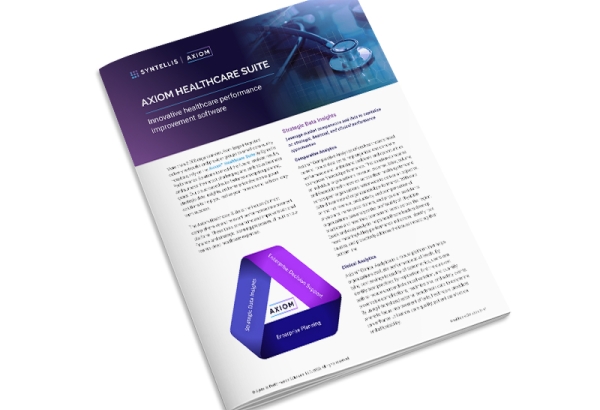Post-allocation management ensures continued alignment of financial performance with strategic planning cash-flow requirements.
How much capital to spend and the initiatives in which to invest are among the most critical decisions made by hospitals or health systems, often through organizations’ capital management executive groups, as supported by their senior management teams and boards. Actions taken after those decisions are made, however, are equally significant in determining organizations’ long-term financial successes.
Post-allocation management is the process that ensures continued alignment of organizations’ financial performance with the cash-flow requirements of initiatives selected to fulfill their strategic plans.
There are four best practices for effective post-allocation management:
- Managing the timing of capital spending
- Reviewing and validating projects prior to final funding
- Ongoing monitoring of capital spending
- Assessing and responding to performance results
#1 — Managing the Timing of Capital Spending
A designated capital management executive group (the “group”) should manage the overall funding schedule for approved “threshold” capital projects. These projects have costs at or above a defined dollar amount and require extensive analysis and centralized review. They form the bulk of organization’s annual capital investment portfolios, and should be ranked according to priority based on both quantitative and qualitative factors.
Detailed information enables the group to proactively manage the capital portfolio, coordinating the release of funds based on the original project priorities, anticipated project timing, and organizational cash flow. The finance team should routinely provide the group with an overall schedule of the hospital or health system’s projected cash flow for the upcoming fiscal year, including its current liquidity position and projected cash flow by quarter.
If it becomes clear that an organization has insufficient capital capacity due to operating underperformance or other unanticipated calls on its liquidity, the group may defer spending on threshold capital projects. Quarterly or mid-year review of financial performance provides a true picture of the organization’s financial trajectory. As performance expectations are updated, the group can determine whether funding needs and capital availability are in balance, or if spending adjustments are needed.
#2 — Review and Validation of Projects Prior to Final Funding
Approved capital project parameters should be reviewed and revalidated before final funding is released. This helps ensure any material post-approval changes to a project are assessed and integrated into the organization’s financial plan.
The project sponsor initiates the revalidation process by submitting a request to start the project and release project funding. Some organizations may require detailed information to initiate funding, while others delegate project finalization to the project sponsor, within broad parameters. With either approach, the responsibility for moving the funding request forward ultimately rests with the capital management executive group.
#3 — Ongoing Monitoring of Capital Spending
Post-approval reviews and monitoring are vital to the integrity of capital management processes. Successful organizations define quantifiable indicators of project success as part of their business plans, measure and report performance against these indicators, and implement steps to respond to less-than-anticipated performance.
Ongoing measurement of actual investment performance must be built into both the governance and the calendar of capital management processes. Post-project monitoring helps ensure that cost and revenue projections are reasonable and on target and that project sponsors are held accountable.
The capital management executive group should define the post-allocation monitoring time frame for review of every approved threshold capital project. Some organizations review projects each year until after completion and one full year of operations. This includes projects for which operations begin in the first investment year as well as multiyear projects that do not begin operations for several years.
Post-allocation monitoring should mirror analyses prepared in support of original allocation decisions, including use of the same benchmarks and metrics. A project tracking form structured to mirror the capital request form is recommended. This standardization reinforces for project sponsors that assumptions and projections used to develop business plans will become performance evaluation metrics, resulting in improved up-front analyses and management of post-allocation project performance.
Occasionally, capital projects do not require as much funding as originally projected in business plans. This may become evident during revalidation processes or upon project completion. Policies should be in place to address unspent capital for threshold capital projects to ensure these funds are returned to organizations and not used inappropriately.
#4 — Assessing and Responding to Performance Results
Not all capital projects will be successful. Healthcare leaders should avoid waiting too long to modify or exit bad capital investment decisions. Project business plans must define exit strategies, including when underperforming projects should be ended, based on specified project metrics.
To give project performance-review processes “teeth,” the capital management executive group should consider employing one or more of the following strategies for retrospective evaluation of each threshold project:
- Retrospective reviews of randomly selected projects at different stages of completion
- Retrospective reviews of all approved projects as a prerequisite to submitting capital requirements in subsequent years’ capital processes
- Sharing of retrospective reviews with organizations’ boards
- Creation of direct links between capital approvals and operating budgets to ensure that operating impacts projected for specified projects actually occur Given current pressures on operating margins, it is more vital than ever for healthcare leaders to focus on relationships between their hospital or health systems’ strategic plans and their capital capacities. Thoughtful design and implementation of post-allocation management of capital through the best practices described here will encourage project sponsors to meet the performance targets established in their business plans, thus positioning organizations for continued success going forward.
Learn more about financial planning in healthcare

Financial Planning and Decision Support Software for Healthcare Organizations

5 Steps to Effective Capital Budgeting in Healthcare


